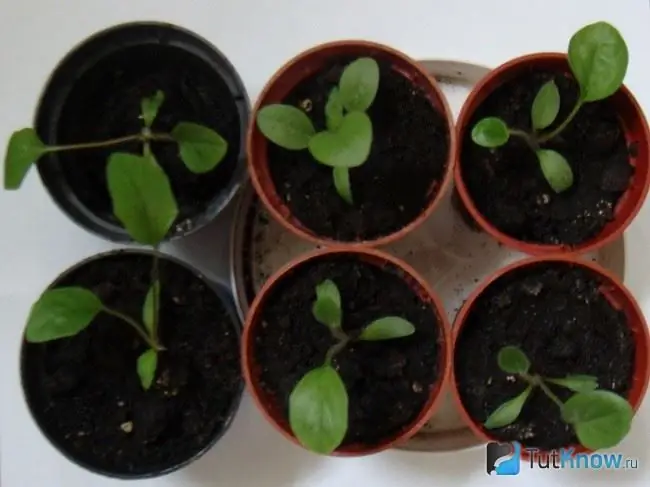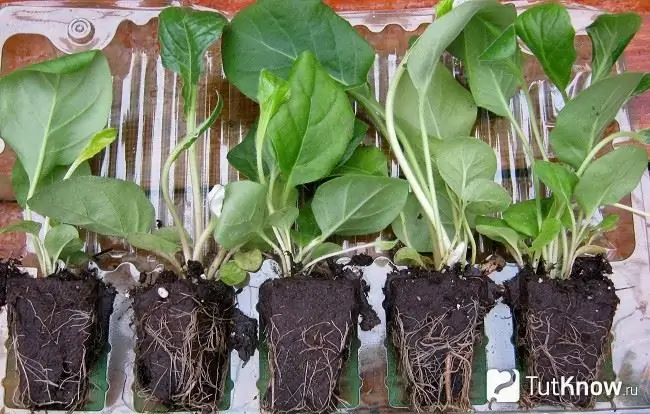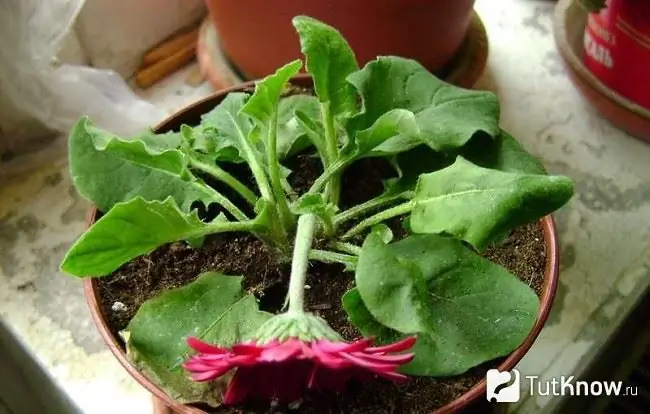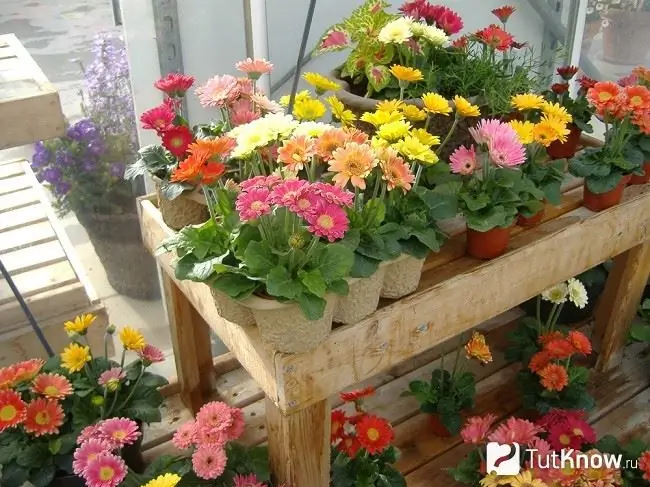Distinctive features of the plant, tips for cultivating at home, reproduction, difficulties in growing a flower, interesting facts, types. Many are familiar with this flower, which resembles an unusual chamomile or aster with beautiful shades of its petals. We often met this Asteraceae in bouquets that were surprisingly durable. Now let's look at how to indulge in the pleasure of owning and growing this truly ornamental plant - Gerbera.
This flower is a genus of multicolored specimens of flora that have a herbaceous form of growth and belong to the Asteraceae family, or, as already mentioned, Compositae, bearing the name Asteraceae in Latin. Most of these magnificent flowers revere the lands of South Africa and the islands of Madagascar with their native territories, but there are also those who "chose" the Asian regions for their lives in those regions where the tropical climate prevails. In total, this genus contains up to 70 varieties.
In their outlines, the blossoming gerbera flowers are very similar to similar "chamomile" specimens of the green world, which belong to other genera, for example, such as Nivyanik, Osteospermum and others. Gerbera petals can take on a wide variety of tones, with the exception of blue.
The first mention of this genus appeared in 1737 thanks to the Dutch botanist Jan Gronovius, who lived in the years 1690-1762. Thus, the scientist decided to immortalize the name of his colleague, who also had a hand in the study of botany - the German physician and naturalist Traugott Gerber (1710-1743). He became famous for the fact that he served for some time as director of the Moscow Botanical Garden, which bears the name of the "Pharmaceutical Garden" in 1735-1742. Also Gerber was constantly engaged in research of representatives of flora in the territories of the Volga region. And already in 1758, when Karl Linnaeus began to systematize the plants of the planet, known at that time, he used this name in his works. Since until May 1, 1753, all the names of specimens of the "green world" were not considered published, this scientific term began to be used for all species of the genus and Linnaeus from a formal point of view is considered the founder of this flower name - Gerbera.
However, it is possible to find in literary sources another theory of the origin of this name - since in Latin the word “grass” sounds like “herba”, this became the basis for assigning this name to the flower. But in the old lady of Great Britain in the botanical literature there is one wonderful nickname for gerberas - "Transvaal daisy" or "Transvaal daisy".
Most often, it is customary all over the world to grow this beautiful flower not only in gardens, you can find it in greenhouses or even as an indoor culture. Naturally, the flowers of this plant are cut to decorate bouquets and phytocompositions. Gerberas are herbaceous plants with a long life cycle. It has elongated leaf plates, which are distinguished by pinnately dissected outlines. There is a sharpening at the ends and they can be up to 35 cm in length, from which a basal rosette is assembled. There are varieties in which the petioles and leaf bases have strong pubescence. Flowering stems can reach a height of up to 60 cm, not leafy, often also covered with fluff.
The pride of this plant is naturally the flowers. Of these, like other representatives of the Aster family, the inflorescences collected from the buds are in the shape of baskets. They are located singly and reach a diameter of 4-15 cm, but there are varieties in which the flower can reach up to 30 cm in diameter. Flowers located at the edges have tongues and have a very diverse shade. Those that are located in the center are very small with tubular outlines and a basket is connected from them, the number of individual buds in which can reach several hundred. The flowering process of one plant can take 3-4 months and it occurs both in spring and autumn.
After flowering, the fruit ripens in the form of an achene, which is a simple paracarpous single-seeded formation, and the weight of one seed can reach 0, 003 grams. This seed does not lose its germination capacity for up to six months.
Based on the basic varieties, breeders have developed new varieties, the height of which rarely exceeds 25-30 cm. With the help of such hybrids, it is customary to plant balconies and terraces. Gerbera is a thermophilic plant and it will not tolerate wintering in our conditions in the open field. When the cultivation takes place indoors, the flower does not differ in durability, and it is necessary to rejuvenate the bush after 3-4 years.
Gerbera cultivation, home care

- Illumination. The plant thrives on sunny windowsills of east, west and south windows. However, on the latter in the summer, it is necessary to hang curtains to avoid sunburn, or to rearrange the pot in a shady place. With the arrival of summer, you can take the gerbera out onto the balcony, having previously taken care of the shade in the midday hours of summer. Drafts are not scary for her.
- Growing temperature. The plant thrives at room temperatures, but not in heat. Thermometer readings should not go beyond 16-22 degrees in the spring and summer. With the onset of autumn, these rates can be gradually lowered and brought to 14-16 degrees, but it is important not to carry out this procedure abruptly.
- Air humidity when growing gerbera is not essential, but if you spray the leaves, then the plant will only be grateful. In this case, it is necessary to try so that drops of moisture do not fall on the flower petals. The spray water is soft and warm. With a decrease in humidity, the plant begins to be affected by pests.
- Watering the "transvaal daisy" regular is required, if the earthen coma is allowed to dry, this will negatively affect the flower. Filling the soil is also not permissible, since gerbera is easily affected by all kinds of rot caused by fungal diseases. Water for irrigation should be 18–20 degrees and free of impurities and hardness. If you pour cold water in the summer heat, the gerbera can even die.
- Gerbera fertilization. It is necessary to make top dressing 3-4 times a month. When the leaves are being formed, it is recommended to give preference to nitrogenous fertilizing, and then, during flowering, to complete mineral complexes.
- Transplantation and selection of soil. In early spring, if the bush has grown a lot, then you can change the pot and soil for the gerbera. The capacity is selected a little more than the previous one, drainage at the bottom is required. In the bottom, it is also required to make holes to drain excess moisture. If the pot is chosen too large, flowering may not come for a long time. The substrate must be chosen slightly acidic. You can mix sheet soil, peat soil and river sand in proportions (2: 1: 1).
- Gerbera pruning. There is no need to carry out such a procedure for the bush, only the flowering stems of faded flowers should be broken out, since the remains of the peduncles can lead to decay and loss of the plant.
- Bloom. Gerbera stops blooming in winter due to lack of light, but if backlighting is provided, flowering will continue, but the plant will be depleted. And in summer there may be no flowers due to the heat and long daylight hours. It is best to stick to the natural cycles of the gerbera.
Reproduction of "transvaal chamomile"

It is possible to get a new gerbera bush by planting seeds, cuttings or dividing the bush.
When grown from seeds, germination takes about 30 days, and from sowing to the appearance of flowers, it will take about 10-11 months. However, the signs of the mother bush may not persist.
Sowing of seed material is carried out no later than 5-6 months after it ripens and it is better if this time falls in March. Before sowing, the peat-sand mixture must be steamed (disinfected). Seeds are recommended to be soaked and then sown in containers filled with prepared soil. From above you need to sprinkle them with clean sand and spray from a spray bottle. Then the container with crops is wrapped in plastic wrap or placed under glass. The place where the container is installed should have diffused illumination and a temperature of about 20-22 degrees. The first shoots can appear in 7 days.
After 2-3 weeks, it is recommended to dive the seedlings and carry out the obligatory pinching of the elongated root. When planting, young gerberas are installed so that the leaf rosette is 1 cm above the ground level.
If it is necessary to propagate especially valuable varieties of gerberas, then the method of dividing the bush is used and the plant should have 3-4 years of life. This operation is carried out in the summer months, when the plant is in relative dormancy. It is recommended to cut the bush into pieces (delenki) or carry out a simple division. When cutting, the gerbera bush is not removed from the pot, but only the soil is cleaned from the top and cut into 2 parts with a sharpened knife. The sections are then powdered with crushed charcoal and sprinkled with dry soil. After this, the delenki are moistened carefully. When they have new roots, the division process is completed by replanting parts of the gerbera in separate containers.
But the method of grafting at home is problematic and unreliable to obtain a new gerbera, this method is only good when grown in Dutch greenhouses.
Difficulties in cultivating gerbera

The problems that accompany the cultivation of "transvaal chamomile" are due to the violation of the conditions of detention:
- excessive watering causes fungal diseases and the manifestation of powdery mildew;
- fusarium and late blight, which begin with rotting of the root system with constant flooding of the soil.
In case of fungal diseases, it will be necessary to carry out an urgent transplant into a new disinfected soil and treat the bush with a fungicide.
It happens that the gerbera is affected by harmful insects, among which aphids, thrips and spider mites are distinguished. In this case, the leaf plates begin to turn yellow and fall off. The consequence of this is a low humidity in the room, it is necessary to carry out an insecticide treatment.
Interesting facts about gerbera

Also, like many members of the Aster family, gerbera also contains derivatives of a substance such as coumarin. It is actively used as a flavoring agent in the perfumery and tobacco industry. In medicine, it is also necessary for the creation of indirect anticoagulants. It is curious that coumarin is also used in electroplating to give a strong shine to products.
If we take into account the flower business, then the gerbera in June (for example, 2008) already occupied the 5th position in terms of sales of its flowers, which were grown for cutting, giving way only to roses, carnations, chrysanthemums and tulips.
If you put a bouquet of gerberas in a vase of water, then the flowers can last up to 20 days. But if you want your phytocomposition to stand even longer, then very little liquid is poured into the container in order to prevent the stem from rotting.
To date, more than 1000 varieties of gerberas are known, which differ from each other not only in color, but also there are colored varieties of varieties within one flower. In some varieties, the color in the central part of the bud can be painted in a practical black shade. There are also differences in the shape and size of the flowers.
When it is necessary to cut a flower, it is recommended to literally break the peduncle out of the leaf outlet, since a very small part of the flower-bearing stem remaining in the bush can lead to the beginning of rotting of the entire plant. In connection with the gerbera, there is a legend according to which there was a nymph with this name, and her beauty did not leave indifferent either men or women. Everyone admired her. This tired the nymph so much that she decided to turn into a simple wild flower. So the gerbera arose, which among some peoples is a symbol of the highest modesty and innocence.
Gerbera species

- Gerbera jamesonii Happipot is the most common of the varieties of this genus. A perennial with a deep rhizome system and forming shoots reaching 30–45 cm in height, and the width of the bush reaches 60 cm. The leaf plates are inverse lanceolate, they are deeply divided into lobes and pinnately incised. In length, they can reach 15–45 cm. Their color from the upper part is saturated dark green, and from the lower part it is lighter and has a rare or dense pubescence. The flower-bearing stem can reach a height of 25–30 cm, and besides, it is longer in gerberas that emerge from seeds. The flowers are arranged one by one, have outlines similar to daisies, the petals of which are painted in orange-bright red tones. In diameter, the bud reaches 8–12 cm in opening. The central tubular flowers are small, with a yellow color scheme. The flowering process occurs in May-June.
- Gerbera viridifolia or as it is sometimes called emerald-leaved Gerbera. Its roots are whip-like, slightly fleshy and fusiform, reaching 1–4 mm in width. The leaf plates can reach a length of 5–6 cm and a width of up to 1, 5–10 cm. Their petiole is long and can grow up to 26 cm, but may be absent. The color of the leaves of fresh greenery on top, and the lower part is much paler and has light pubescence. The stem can grow up to 69 cm in height with a maximum width of 5 mm. It is wider at the base, and there is a narrowing towards the apex. Bracts measure about 4–17 mm in length and up to 1–2 mm in width. Their shape is lanceolate. The petals of the inner flowers are whitish with pinkish tones, while the outer ones can be of all shades of pink, red, lilac, lilac, raspberry and purple, sometimes yellow is also found. Achenes ripen up to 6–12 mm in length; they are covered with pubescence in the form of hairs. The homeland of this variety is all territories of southern and eastern Africa (Highland, Ethiopia, South Sudan and Somalia, as well as the lands of Uganda, Kenya, Malawi, Zaire and other southern countries).
Most of the new varieties are hybrid plants created by combining two South American varieties - the Jameson Gerbera and the Green-leaved Gerbera. Among them, the most popular are:
- Alcor and Aldebaran - with narrow petals in the bud with small flowers, the diameter of which does not go beyond 8-10 cm, the total height of the stem is not less than 40-50 cm;
- species Migar, Vega, as well as Algol and Jupiter can reach with their stems 60–70 cm in height, the diameter of a flower reaches 10–13 cm, petals are narrowed;
- Mars has a height of 65–70 cm, the size of the flower is average, reaching 11–13 cm in diameter, the petals are medium;
- Golden Serena has flowers with a diameter of about 12 cm and a golden yellowish color of the petals;
- Harley has a small flower with a diameter of no more than 7 cm, the extreme petals of a rich orange color, in the center the tone becomes darker and the inner ones have a burgundy color;
- Red Brigadoon (Brigadoon Red) - flowers in which are double with a red tint of petals.
How to care for a gerbera at home, see this video:






